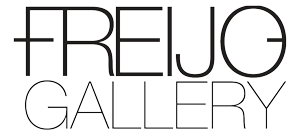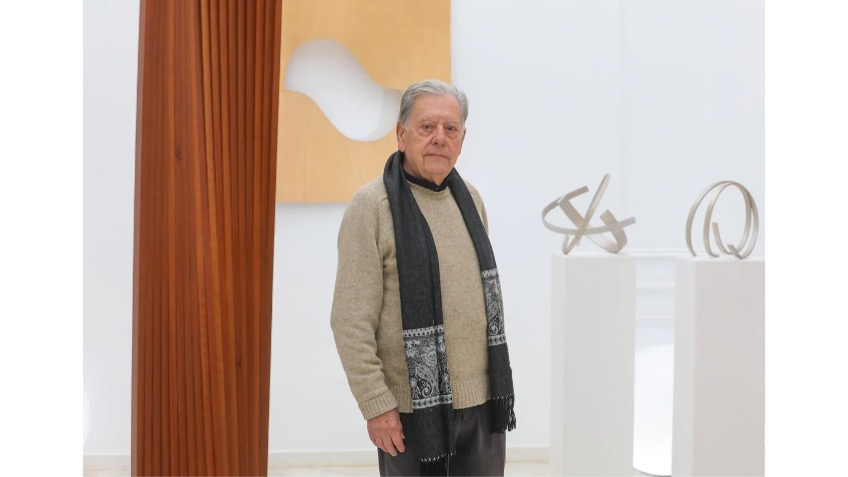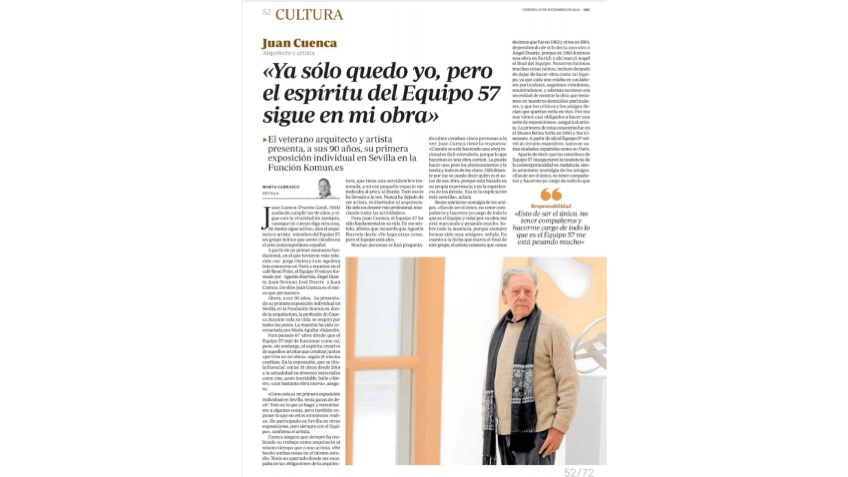Juan Cuenca on ABC newspaper
December 28, 2024
ABC - 27/12/24
Juan Cuenca (Puente Genil, 1934) has just turned 90, and is still as vital as ever, ‘although my body says otherwise, my mind is still active’, says the architect and artist who was a member of Equipo 57, a mythical group that set the standard in Spanish contemporary art.
From an initial founding moment, when they had a closer relationship with Jorge Oteiza and Luis Aguilera after meeting in Paris and meeting at the Rond Point café, Equipo 57 was made up of Agustín Ibarrola, Ángel Duarte, Juan Serrano, José Duarte and Juan Cuenca. Of them Juan Cuenca is the only one who remains.
Now, at the age of 90, he has presented his first solo exhibition in Seville, at the Komun.es Foundation, where architecture, Cuenca's profession throughout his life, is breathed through every pore. The show has been curated by María Aguilar Alejandre.
It has been 67 years since Equipo 57 ceased to function as such, but nevertheless, the creative spirit of those artists who created together ‘lives on in my work’, as he himself confesses. In the exhibition, which is entitled ‘Esencial’, he brings together 35 works from 2014 to the present day in various materials such as zinc, stainless steel, brass or iron, ‘with quite a lot of new work’, he assures.
‘As this is my first solo exhibition in Seville, I wanted to say: ‘This is what I do’, and go back to some things, but also expose what I am doing at the moment. I have participated in other exhibitions in Seville, but always with Equipo’, confirms the artist.
Cuenca says that he has always worked as an architect as well as an artist. ‘I have done both things in the same studio. I had a section where I could escape from the obligations of architecture, which has a tremendous servitude, and in that small space I dedicated myself to art and design. I've done all that at the same time. I have never stopped being an artist, designer or architect. It has been a professional evolution of mine, mixing all the activities’.
For Juan Cuenca, Equipo 57 has been fundamental in his life. In this sense, he says that he remembers Agustín Ibarrola saying: ‘I do other things, but Equipo is there’. He also underlines the fact that ‘the same thing has happened to all of us, we did other things, but Equipo was there. We carry this kind of positive stigma of Team 57. Perhaps because of that leitmotiv, which is the rationality of what we did, the need to explain it, to say that it is before and it is after’.
Many people have wondered how five people created at the same time. Juan Cuenca has the answer: ‘When you are doing a rational work it is easy to understand, because what we do is a common work. One person can do it, but the approaches and the theory and everything belongs to the five of us. It is difficult to say who is the author of this work, because it is based on their own experience and the experience of others. That's the simplest explanation,’ he says.
Cuenca says that he has always worked as an architect as well as an artist. ‘I have done both things in the same studio. I had a section where I could escape from the obligations of architecture, which has a tremendous servitude, and in that small space I dedicated myself to art and design. I've done all that at the same time. I have never stopped being an artist, designer or architect. It has been a professional evolution of mine, mixing all the activities’.
For Juan Cuenca, Equipo 57 has been fundamental in his life. In this sense, he says that he remembers Agustín Ibarrola saying: ‘I do other things, but Equipo is there’. He also underlines the fact that ‘the same thing has happened to all of us, we did other things, but Equipo was there. We carry this kind of positive stigma of Team 57. Perhaps because of that leitmotiv, which is the rationality of what we did, the need to explain it, to say that it is before and it is after’.
Many people have wondered how five people created at the same time. Juan Cuenca has the answer: ‘When you are doing a rational work it is easy to understand, because what we do is a common work. One person can do it, but the approaches and the theory and everything belongs to the five of us. It is difficult to say who is the author of this work, because it is based on their own experience and the experience of others. That's the simplest explanation,’ he says.
Juan Cuenca also says that the members of Equipo 57 were the first artists to anticipate contemporaneity in Andalusia, and then came all the others, ‘we inaugurated this trend’.
Equipo 57's final date
He also feels nostalgia for his friends. ‘That of being the only one, not having any companions and being in charge of everything that is Equipo and looking after its work is leaving its mark on me and weighing heavily on me. Especially the absence, because we have always been very close friends,’ he says. As for the date that marks the end of this group, the artist comments that ‘some say it was in 1962 and others in 1964, depending on whether one or the other or Ángel Duarte said it, because in 1965 we did a work in Zurich and it was there that Ángel marked the end of Equipo. We did many things together, even after we stopped making works as Equipo, since each of us was working in our own private jobs, we continued to see each other, to meet, and we also had the need to show the work we had in our private homes, and that critics and friends said they wanted to see it live. That's why we were almost obliged to hold a series of exhibitions,’ says the artist. The first of these exhibitions was at the Reina Sofía Museum in 1993 and was itinerant. From then on Equipo 57 returned to the exhibition circuit, both in various Spanish cities and in Paris.
In 2007, on the occasion of the fiftieth anniversary of the birth of Equipo 57, a retrospective exhibition of the group was held at the Centro Andaluz de Arte Contemporáneo (Andalusian Centre of Contemporary Art), which brought together works, documentation and objects. At the same museum, Equipo again took part in a group show entitled ‘1957-1975’ together with artists such as José Guerrero, Alfonso Albacete, Bruce Nauman, Pérez Villalta, Gerardo Rueda and Antonio Saura, among others.
‘What we wanted was for the Equipo's work to fall into the hands of cultural entities or good collections, and I think that was an objective that we achieved. And what happened then? Well, we saw each other again very often and we were together again. The Equipo was reborn in us as we managed all our exhibitions. Friendship was always above all else’, says Juan Cuenca.
This architect and painter believes that his work without Equipo 57 navigates well. ‘It is a rational work - he assures us - that is based on a very clear principle, intellectually speaking, and that is evidently the legacy of Equipo. My current work does not resemble that of Equipo, but its spirit is there, it is a work of rehearsal and experiment’.
He believes that time has not taken its toll on his work because ‘art always has to say new things, but sometimes I ask myself: “What am I doing?” And time has not taken its toll on me, perhaps when more years go by..., but that is the human condition. At 90 years old this is what I know how to do, and I do it every day, and I always come up with different things but within the same concept, within a way of understanding art.
He is not sure if the public today understands his work better than it did fifty years ago, ‘because I don't have people's response. I see my work with the public, I explain it, they are attentive, but I have no idea how the ‘boomerang’ works. What is important is that I know how to explain my work’, the painter stresses.
In his work as an architect, there are outstanding works such as the Cordoba bus station, a project he co-directed with César Portela and for which he won the National Architecture Prize, or the bus station in the Plaza de Armas in Seville, as well as the Baena Town Hall, ‘a work I am very fond of, because I even designed the bell tower. In that project, a table was needed for writing the printed matter, a piece of furniture where people could write standing up, so I designed that piece of furniture as well’. He also designed the theatre in Baena, for which he made the seats, ‘I even designed the conductor's lectern’.
Among his works as an architect, the rehabilitation of the Roman bridge in Cordoba and the Calahorra tower, as well as the creation of the Visitor Reception Centre, stand out for their dimension in the city ‘and because it was the one that made me think the most and the last one I did’. It took me ten years of work’. And he coins terms such as ‘artistic architecture’ to define that his satisfaction as an architect goes hand in hand with his satisfaction as an artist.
'Esencial' by Juan Cuenca
Where: Komun.es foundation
Address: calle Madre de Dios, 8
When: 19 December 2024 to 13 March 2025
Time: Open Thursdays from 7 to 9 p.m.
Admission: free
Regarding architecture, he says that we live in an era where the ephemeral dominates, ‘but they keep asking me for things of my work that they are studying and they call me to explain or to give them plans of the bus station. The Andalusian architects, all younger than me, are still very good and continue to work. I don't work in architecture any more, it requires a lot of paraphernalia and a certain entrepreneurial character. I do my artistic work on my own without help, not architecture, it's a very complex profession’, he concludes.



